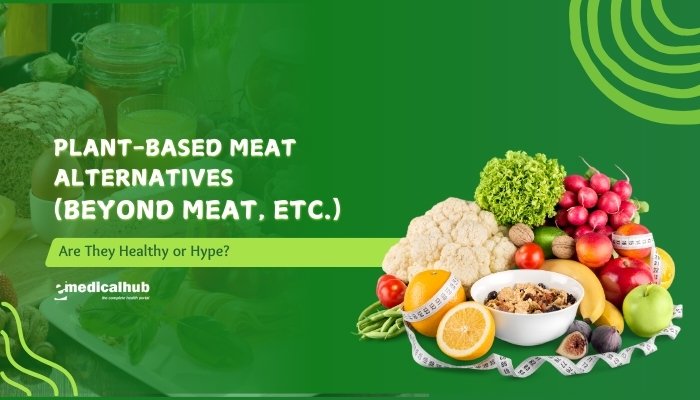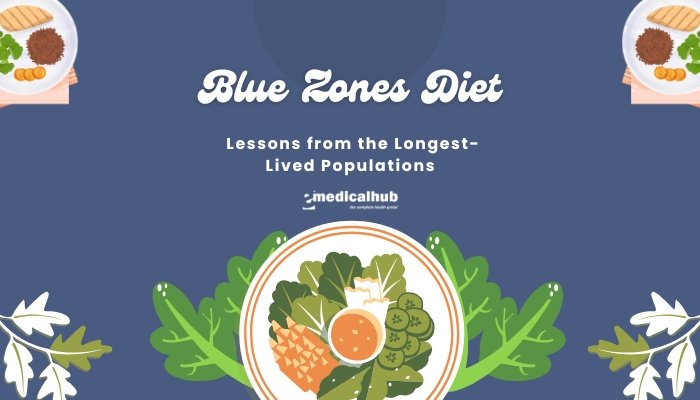Introduction
In the span of just a few years, plant-based meat alternatives have leaped from niche health-food store items to mainstream grocery staples and fast-food menu additions. Brands like Beyond Meat, Impossible Foods, and numerous smaller players now offer everything from plant-based burgers and sausages to nuggets and “ground meat,” made without any animal components.
The industry positions these products as being more sustainable, kinder to animals, and potentially better for human health than traditional meat. But critics question whether heavily processed ingredients can truly be called “healthy” or if the environmental claims always stack up.
This article unpacks the rising phenomenon of plant-based meat analogs, examining their nutritional profiles, environmental footprint, and potential benefits and drawbacks for consumers. We’ll explore how these products compare to real meat in terms of taste, protein quality, and health outcomes.
Whether you’re an omnivore curious about Meatless Mondays, a flexitarian cutting back on animal protein, or a committed vegetarian craving a meaty texture, understanding the facts behind these new-generation products can help you decide if plant-based meats are the real deal—or merely hype.
Disclaimer: This is for educational use and not a substitute for personal medical advice. If you have specific dietary concerns, consult a qualified healthcare provider or registered dietitian.
The Emergence of Plant-Based Meat
From Tofu to Tech-Lab Innovations
Meat alternatives have existed for centuries in various forms—tofu, tempeh, seitan—mostly used in specific cultural or vegetarian contexts. However, recent technological advances have led to highly engineered products mimicking the taste, texture, and even “bleeding” aspect of beef. Companies like Beyond Meat and Impossible Foods rely on:
- Legume Proteins (pea, soy, faba beans)
- Yeast or Soy Leghemoglobin (giving a meat-like color and flavor)
- Plant Oils (coconut, canola) for juiciness and mouthfeel
- Binders, Stabilizers, and Flavorings to mimic the texture, juiciness, and savory taste of real meat
Growth in Popularity
Consumer interest in these products is fueled by:
- Ethical Concerns: Minimizing harm to animals or supporting cruelty-free diets.
- Health and Nutrition: Perceived as healthier, lower in saturated fat, or free of cholesterol.
- Environmental Consciousness: Reduced carbon footprint and resource usage relative to livestock.
- Mainstream Acceptance: Major fast-food chains now carry plant-based burgers, exposing a broader consumer base.
While some see these alternatives as a game-changer for global food systems, others wonder if they’re truly better for health and environment, or just heavily processed creations with a “healthy halo.”
Nutritional Overview of Plant-Based Meats
Protein Content
One main selling point is high protein:
- Beyond Burger and Impossible Burger typically contain around 18–20 grams of protein per patty, comparable to a beef burger.
- Protein sources vary—pea protein isolate for Beyond Meat, soy protein for Impossible Foods, among other blends.
These formulations are designed to approximate the protein level of real meat. However, the type and digestibility of plant proteins can differ slightly from animal proteins, though for most healthy adults, the difference is negligible if the total protein intake is adequate.
Fat and Calories
Many of these alternatives aim to mimic the fat levels of ground beef:
- Some might contain roughly 14–20 g of fat per patty, with saturated fats from coconut oil and canola or sunflower oil.
- The caloric content often lands close to an 80/20 ground beef patty (around 250–290 kcal).
- The saturated fat content can be somewhat high, though still free of dietary cholesterol. For individuals aiming to reduce saturated fat, reading labels is necessary.
Sodium and Additives
Flavoring these products often requires added salt and a range of synthetic or natural additives:
- Sodium can be moderate to high, e.g., 300–400 mg or more per serving.
- Binders and Flavor Enhancers: Methylcellulose, yeast extracts, or heme (soy leghemoglobin) can appear on ingredient lists.
- Natural Colors: Like beet juice extracts or annatto for color.
While not inherently harmful, the processed nature can be a drawback for those seeking minimal or “clean label” products.
Vitamins and Minerals
Many plant-based meats are fortified with vitamins and minerals like B12, zinc, or iron to replicate the micronutrient content of real meat. The bioavailability of iron might vary, but formulations often ensure comparable levels. For vegetarian or vegan dieters, obtaining B12 is a particular advantage if it’s included in the product.
Potential Health Benefits
Reduced Red Meat Intake
Diets high in red or processed meats are linked to an elevated risk of cardiovascular disease and certain cancers. Substituting them with plant-based analogs can:
- Reduce Saturated Fat and Eliminate Cholesterol in a meal, especially if done frequently.
- Provide a source of plant protein that might be more beneficial for heart health in the long run.
Less Risk for Some Chronic Diseases
Research indicates diets heavy in plant foods generally correlate with lower obesity rates, type 2 diabetes, and heart disease. Though it’s uncertain if these new processed patties replicate the same benefits as unprocessed legumes or tofu, they do help shift away from high saturated fat, high-cholesterol red meat.
Ethical and Environmental Gains
From an ethical perspective, reducing reliance on animal agriculture can cut down greenhouse gas emissions, land use, and water consumption. People concerned about cruelty can choose these alternatives while enjoying a meaty texture.
Transition for Meat-Eaters
For those new to vegetarian or flexitarian lifestyles, realistic meat analogs can ease the transition, bridging the gap by providing a familiar taste. This can encourage a more plant-based pattern overall.
Potential Downsides
Highly Processed Nature
Critics argue these items are not inherently “health foods”:
- Refined Oils, Protein Isolates: The raw materials are often heavily processed.
- Additives: Emulsifiers, flavorings, color additives might compromise the “wholeness” factor.
- Excess Sodium: Many are salted to enhance flavor.
While they can be part of a balanced diet, one shouldn’t mistake them for purely natural, minimally processed foods.
Cost and Accessibility
Plant-based meats can be pricier than equivalent ground beef or poultry, at least in certain markets. For people on tight budgets, relying on staples like beans, lentils, or tofu might be more cost-effective for plant-based protein.
Potential GMO or Allergen Concerns
- Soy Leghemoglobin in the Impossible Burger is genetically engineered. Some consumers prefer non-GMO options.
- Protein isolates (like pea or soy) can be allergenic for certain individuals.
Nutrient Gaps vs. Whole Foods
Unlike whole legumes or vegetables, these products lack the fiber, synergy, and micronutrient density that come from less processed plant foods. Relying heavily on them might crowd out more beneficial whole-food choices.
Environmental Considerations
Lower Carbon Footprint Than Beef
Life cycle analyses typically show that producing plant-based burger patties uses significantly fewer resources—water, land, greenhouse gas emissions—than conventional beef. This is a primary selling point for eco-conscious consumers.
Not Perfect
Although significantly reduced relative to meat, these items still require:
- Agricultural land for soy, peas, or other crops
- Energy for processing and packaging
Nonetheless, compared to livestock-based meat, the net environmental savings are generally positive if properly scaled and responsibly sourced.
Balanced Approach to Plant-Based Meat Alternatives
Moderation is Key
While they can help reduce red meat intake, these alternatives shouldn’t dominate the diet. They can be occasional replacements for ground meat or sausage but are best supplemented by:
- Whole Legumes (beans, lentils)
- Tofu, Tempeh
- Nuts and Seeds
This ensures diverse nutrient sources and less reliance on processed foods.
Read Labels Carefully
Check:
- Protein Content: Typically ~15–20 g per serving—this is good, but compare with your daily goals.
- Saturated Fat: Some can have about 5–8 g per serving—similar to or slightly less than real beef.
- Sodium: Look for moderate levels (<350 mg per patty, if possible).
- Additives: If you prefer simpler labels, pick brands with fewer artificial additives or colorings.
Culinary Tips
- Cooking: Cook to recommended temperatures (some instructions differ from real beef). Overcooking can yield dryness or burnt flavors.
- Seasoning: Although they’re pre-flavored to mimic meat, a dash of marinade, fresh herbs, or sauces can elevate them.
- Texture: Accept that perfect replication of texture may vary—some prefer certain brands for their unique mouthfeel.
Real-World Examples and Use Cases
Transitioning Flexitarian
A person cutting down on red meat might substitute plant-based burgers once or twice a week. They find it helps reduce saturated fat intake, and maintain protein. Over time, they incorporate more lentils and chickpeas, too, for variety.
Strict Vegan Replacement
Vegans wanting a burger-like meal may rely on these products for convenience or social events. They ensure broad coverage of protein by also including beans, grains, and vegetables. Some prefer homemade veggie patties for less processing, but store-bought can be a quick fix.
Athlete Concerned with Performance
An athlete exploring more plant-based meals might use these high-protein patties post-workout, complementing them with a balanced macros approach. They keep an eye on sodium levels, ensuring adequate micronutrient intake from produce and supplements if needed.
Frequently Asked Questions (FAQ)
Are these meat alternatives healthier than real meat?
“Healthier” is context-dependent. They generally contain no cholesterol and lower saturated fat, but they are processed and can be high in sodium. Compared with high-fat red meat, some might be a better choice for heart health, but eating less processed whole foods is usually ideal.
Do plant-based burgers taste exactly like beef?
Taste is subjective. Many find them close, especially modern formulations, but nuances remain. Texture, mouthfeel, and aftertaste can differ from brand to brand.
Are they suitable for weight loss?
They can be, if they fit into a calorie-controlled plan. However, many are calorically similar to 80/20 ground beef. Balancing overall diet and portion sizes is crucial.
Do I need to worry about soy leghemoglobin or GMO ingredients?
Some alternatives use genetically engineered organisms (e.g., heme in Impossible Foods). If you prefer non-GMO or organic, check brand details. From a regulatory standpoint, these are considered safe in the US.
Will these products help reduce colon cancer risk?
Reducing processed red meat might lower certain cancer risks, but the effect of substituting with processed plant-based items is less clear. The advantage might come more from removing red/processed meat than from the addition of these specialized products, though it’s likely beneficial if they fit an overall nutritious diet.
Conclusion
Plant-based meat alternatives like Beyond Meat and Impossible Foods represent a culinary and environmental innovation—offering the taste and texture of meat with fewer ethical and ecological concerns. Nutritionally, they provide comparable protein levels and often lower saturated fat than typical red meat, though they’re by no means unprocessed or guaranteed healthy. Their role in a balanced diet can be positive if approached with awareness of sodium, saturated fats, and overall dietary variety.
Ultimately, for those seeking to reduce animal consumption, adopt more eco-friendly habits, or find convenient high-protein vegetarian options, these products can serve as useful transitional or occasional choices. Emphasizing whole foods (like beans, lentils, or tofu) remains a crucial cornerstone of plant-based diets. Meanwhile, mindful selection of a brand or product that aligns with your nutritional and ethical priorities helps ensure that enjoying these new-generation patties or sausages becomes a valuable addition to a varied, nutrient-packed eating pattern.
References
- Joshi VK, Kumar S. Meat analogues: Plant based alternatives to meat products – a review. Int J Food Ferment Technol. 2015;5(2):107-119.
- Beyond Meat. Official website. Nutrition facts. Accessed 2023.
- Impossible Foods. Official website. Product specs. Accessed 2023.
- Willett W, Rockström J, Loken B, et al. Food in the Anthropocene: the EAT–Lancet Commission. Lancet. 2019;393(10170):447-492.
- Smetana S, Mathys A, Knoch A, et al. Meat alternatives: life cycle analysis. Crit Rev Food Sci Nutr. 2015;55(5):740-52.
- Hu FB, Otis BO, McCarthy G. Plant-based diets and the risk of cardiovascular disease. Trends Cardiovasc Med. 2020;30(8):399-408.
- He J, Evans A, Liu Z, et al. Replacement of red meat with alternative plant-based proteins. BMJ. 2019;364:l216.
- Melina V, Craig W, Levin S. Position of the Academy of Nutrition and Dietetics: vegetarian diets. J Acad Nutr Diet. 2016;116(12):1970-80.
- U.S. Food & Drug Administration. GRAS status for plant-based heme. 2019.
- Pulkkinen M, et al. The effect of partial replacement of meat with plant-based proteins on diet. Nutrients. 2021;13(1):74.
- Harvard T.H. Chan School of Public Health. Protein in the diet. 2022.
- Noakes M, et al. A comparison of alternative protein diets for overweight individuals. J Nutr. 2021;151(2):252-258.




